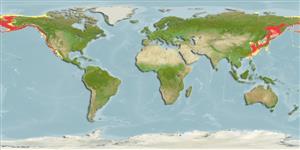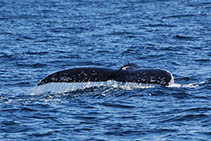Advertisement
Eschrichtius robustus (Lilljeborg, 1861)
Gray whale| Native range | All suitable habitat | Point map | Year 2050 |

|
| This map was computer-generated and has not yet been reviewed. |
| Eschrichtius robustus AquaMaps Data sources: GBIF OBIS |
United States (contiguous states) country information
Common names:
[No common name]
Occurrence: native
Salinity: marine
Abundance: | Ref:
Importance: | Ref:
Aquaculture: never/rarely | Ref:
Regulations: no regulations | Ref:
Uses: no uses
Comments: Skeletal parts unearthed from about A.D. 1675 in the eastern United States based on historical accounts in New England in the early 1700s (Ref. 1522). C: Refs. 1522, 3753, 74613, 94794.
National Checklist:
Country Information: https://www.cia.gov/library/publications/resources/the-world-factbook/geos/us.html
National Fisheries Authority: http://www.nmfs.gov
Occurrences: Occurrences Point map
Main Ref: Rice, D.W., 1998
National Database:
Occurrence: native
Salinity: marine
Abundance: | Ref:
Importance: | Ref:
Aquaculture: never/rarely | Ref:
Regulations: no regulations | Ref:
Uses: no uses
Comments: Skeletal parts unearthed from about A.D. 1675 in the eastern United States based on historical accounts in New England in the early 1700s (Ref. 1522). C: Refs. 1522, 3753, 74613, 94794.
National Checklist:
Country Information: https://www.cia.gov/library/publications/resources/the-world-factbook/geos/us.html
National Fisheries Authority: http://www.nmfs.gov
Occurrences: Occurrences Point map
Main Ref: Rice, D.W., 1998
National Database:
Common names from other countries
Классификация / Names народные названия | синонимы | Catalog of Fishes (gen., sp.) | ITIS | CoL | WoRMS
Environment: milieu / climate zone / depth range / distribution range экология
пелагический; мигрирует в океане (ссылка 75906); пределы глубины 1 - 2500 m, usually 30 - 500 m. Tropical; 90°N - 0°S, 115°E - 105°W
Distribution страны | регионы FAO | Ecosystems | места находок | интродукции
Pacific Ocean, Atlantic Ocean and the Arctic: Extinct in North Atlantic; two populations in North Pacific. Tropical to polar. [western population: IUCN 2010 (Ref. 84930): CR, C2a(ii);E.]
Length at first maturity / Size / Weight / Возраст
Maturity: Lm 1,220.0 range ? - ? cm Max length : 1,500 cm TL самец/пол неопределен; (ссылка 1394); наибольший вес (опубликованные данные): 35.0 t (ссылка 1394); наибольший возраст (опубликованны данные): 48 годы (ссылка 128170)
Lives within a few tens of kilometers of shore. Bottom feeders that feed primarily on swarming mysids and tube-dwelling amphipods in the northern parts of their range, but are also known to take red crabs, baitfish, and other food opportunistically. The North Atlantic stock was apparently wiped-out by whalers in the 18th century. A western North Pacific (Korean) stock may also have been extirpated in the mid 20th century; its continued existence as a small remnant is still debated. The eastern North Pacific (California-Chukotka) stock nearly suffered the same fate twice, once in the late 1800s and again in the early 1900s. Both times, a respite in commercial whaling allowed the population to recover. About 170 to 200 from this latter stock are killed annually under special permit by commercial whalers on behalf of Soviet aborigines, and one or a few are taken in some years by Alaskan Eskimos. Since receiving IWC protection in 1946 and the end of research harvests in the late 1960s this population has increased, and now apparently equals or exceeds pre-exploitation numbers (Ref. 1394). Lives within a few tens of kilometers of shore. Bottom feeders that feed primarily on swarming mysids and tube-dwelling amphipods in the northern parts of their range, but are also known to take red crabs, baitfish, and other food opportunistically (Ref. 1394).
Основная ссылка
ссылки | координатор | соавторы
Jefferson, T.A., S. Leatherwood and M.A. Webber. 1993. (ссылка 1394)
Статус Красного Списка МСОП
(ссылка 130435: Version 2024-2)
Не вызывающий беспокойства (LC) ; Date assessed: 30 December 2017
Статус СИТЕС (ссылка 108899)
Appendix I: International trade banned
CMS (ссылка 116361)
Not Evaluated
Использование человеком
рыболовство: коммерческий
FAO - рыболовство: landings, Видовой профиль | FishSource | Sea Around Us
инструменты
дополнительная информация
ресурсы в Интернет
BHL | BOLD Systems | CISTI | DiscoverLife | FAO(рыболовство: Видовой профиль; publication : search) | GenBank (Геном, Нуклеотид) | GloBI | Gomexsi | Google Books | Google Scholar | Google | PubMed | Tree of Life | Wikipedia (Вперёд, поиск) | Zoological Record
Estimates based on models
Preferred temperature
(Ref. 115969): 0.4 - 17.3, mean 3.5 (based on 1706 cells).
устойчивость к внешним воздействиям
(ссылка 69278)
средний (среднего размера), минимальное время удвоения популяции 1.4-4.4 года (K=0.19-0.25; tm=8; tmax=48).
Категория цены
(ссылка 80766):
Unknown.




